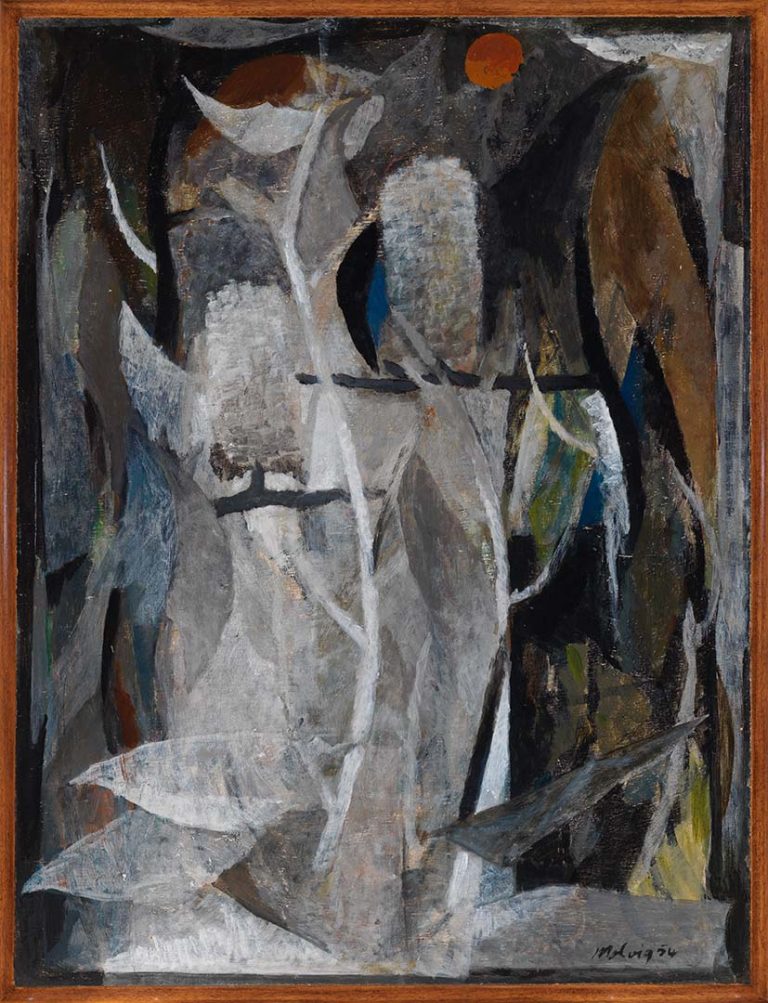We acknowledge the Traditional Owners of the land on which the Queensland Art Gallery | Gallery of Modern Art stands and recognise the creative contribution First Australians make to the art and culture of this country.

Jon Molvig / Australia 1923–70 / Banksias 1954 / Oil on composition board / 83.2 x 63cm / Bequest of Karl and Gertrude Langer 1985 / Collection: Queensland Art Gallery | Gallery of Modern Art / © Otte Bartzis
Jon MolvigBanksias 1954
Not Currently on Display
Ever since his return to Australia from Europe in 1952, Jon Molvig had been interested in finding a personal expression of Australia. Banksias is an early experiment that combines an Australian subject with European influences.
In this still life, Molvig depicts a vase of banksia flowers, uniting the flat geometric patterning, used by artists Nicolas de Staël (1914–55) and Maria Helena Vieira da Silva (1908–92), with the chalky, earthy colours of Indigenous bark paintings.
Molvig considered these works failures, and in an interview in 1964, he said:
I was doing some Aboriginal paintings and trying to do something with it . . . ally it with European painting and make a new school . . . I didn’t succeed very well. But later on when I went through Central Australia, I think I succeeded to some extent; not in painting a landscape . . . but in having an attitude — an Australian attitude towards the country and the people I painted.1
Endnotes:
1 Jon Molvig, quoted in Betty Churcher, Molvig: The Lost Antipodean, Allen Lane, Ringwood, Vic., 1984, p.36.
Jon Molvig was born in Newcastle, Australia, in 1923. After serving in New Guinea and the Philippines during World War Two, Molvig studied art for three years in Sydney, then went on to travel throughout Europe, where he encountered the German and Norwegian expressionists who would significantly influence his work.
From 1955 until his death in 1970, Molvig was based in Brisbane. A complex man, his career was characterised by radical shifts in style. Molvig was also known for his highly considered exploration of technique and the power of his symbolism.
It’s a matter of inventing symbols for what you want to say and putting the symbols down in paint . . . I believe that for every subject you tackle you must invent a new set of symbols and sometimes a new technique to say what you want to say.1 — Jon Molvig
Endnotes:
1 Jon Molvig Interviewed by Hazel de Berg in the Hazel de Berg Collection [sound recording], Hazel de Berg Collection, National Library of Australia, Canberra; DeB 15, June 1961, <http://nla.gov.au/nla.obj-214255022>, accessed July 2019.
Discussion Questions
1. How has Molvig used tone to create depth in Banskias 1954?
2. Molvig wanted to find his own personal expression of Australia in his work. Consider the work of other Australian artists, such as Arthur Boyd (1920–99), Sidney Nolan (1917–92) and Russell Drysdale (1912–81). What was their personal expression of Australia? How do their approaches compare to Molvig’s?
Classroom Activities
Arrange a still-life composition. Create depth in your arrangement by placing some objects in front of others. Sketch the composition and then paint over it, using darker colours in the background and lighter colours in the foreground.